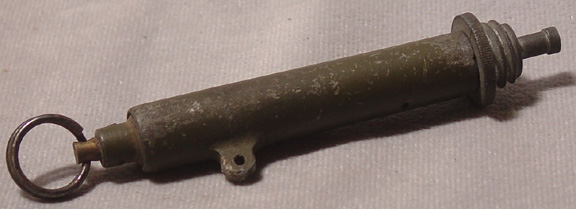Home / Shop
Pressure Switch release Device M1


- Description
- Specifications
In August 1943 The A. C. Gilbert Co. developed this lighter in collaboration with Mr. J. P. Roysdon of the Engineer Board. The M2 Fuse Lighter was more weatherproof than the earlier M1 Lighter and basically replaced it in use by the end of the war. It was waterproof, could ignite fuse underwater and would also ignite fuse at night without showing a flash. The A. C. Gilbert Co. produced the first contract of 5000 in 1943 and eventually received contracts for over 6 million of the devices.
The lighter consists of a zinc alloy body, steel striker and striker spring, safety pin, and special base coupler. The body is a tube turned over on one end and internally threaded at the other. The striker is a simple shaft with a striker head on the bottom and a hole through the top end. The striker is forced up against the spring until the end protrudes out the top end and the safety pin can be inserted. The special base coupler has a spring snout to hold the fuse but it is covered by a shroud for its entire length. The shroud helps in weatherproofing it and preventing flash if used at night.
The lighter is issued complete and ready to use right out of the box. For use, simply insert the end of the fuse in the coupler and push fully home. The spring snout will grip the fuse and prevent its removal. When ready, simply pull out the safety pin which will release the striker to fly down, propelled by the striker spring to hit the primer in the base coupler. The primer flash will ignite the fuse.
The lighters were packed in cardboard cartons with a label on the top that stated “ NOTE: TO BE USED ONLY FOR FRONT LINE DEMOLITIONS OR UNDER ADVERSE WEATHER CONDITIONS”. When packed there is a cardboard tube covering the base coupler and a rubber plug in the end of the base coupler. The lighters are painted olive green or black with markings in yellow or white.
In August 1943 The A. C. Gilbert Co. developed this lighter in collaboration with Mr. J. P. Roysdon of the Engineer Board. The M2 Fuse Lighter was more weatherproof than the earlier M1 Lighter and basically replaced it in use by the end of the war. It was waterproof, could ignite fuse underwater and would also ignite fuse at night without showing a flash. The A. C. Gilbert Co. produced the first contract of 5000 in 1943 and eventually received contracts for over 6 million of the devices.
The lighter consists of a zinc alloy body, steel striker and striker spring, safety pin, and special base coupler. The body is a tube turned over on one end and internally threaded at the other. The striker is a simple shaft with a striker head on the bottom and a hole through the top end. The striker is forced up against the spring until the end protrudes out the top end and the safety pin can be inserted. The special base coupler has a spring snout to hold the fuse but it is covered by a shroud for its entire length. The shroud helps in weatherproofing it and preventing flash if used at night.
The lighter is issued complete and ready to use right out of the box. For use, simply insert the end of the fuse in the coupler and push fully home. The spring snout will grip the fuse and prevent its removal. When ready, simply pull out the safety pin which will release the striker to fly down, propelled by the striker spring to hit the primer in the base coupler. The primer flash will ignite the fuse.
The lighters were packed in cardboard cartons with a label on the top that stated “ NOTE: TO BE USED ONLY FOR FRONT LINE DEMOLITIONS OR UNDER ADVERSE WEATHER CONDITIONS”. When packed there is a cardboard tube covering the base coupler and a rubber plug in the end of the base coupler. The lighters are painted olive green or black with markings in yellow or white.